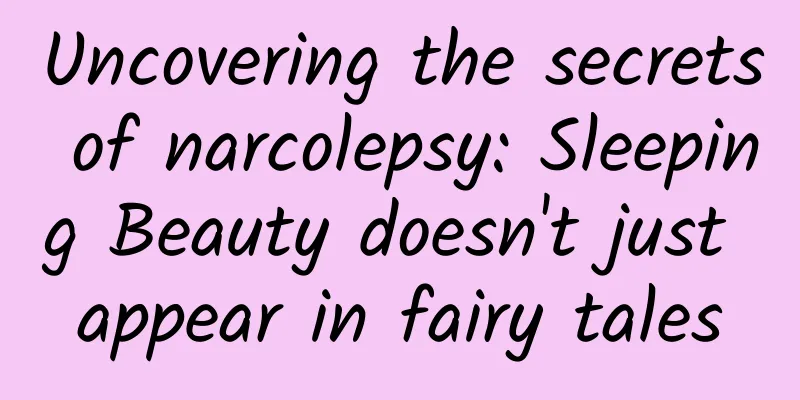Uncovering the secrets of narcolepsy: Sleeping Beauty doesn't just appear in fairy tales

|
Author: Wang Xiaoyu, deputy chief physician of Shijiazhuang People's Hospital, Hebei Province Reviewer: Dong Xiaosong, Chief Physician, Peking University People's Hospital "Sleeping Beauty" is one of the classic stories in "Grimm's Fairy Tales" and is deeply loved by people. But do you know? In our lives, there are also "Sleeping Beauties", but they are different from the Sleeping Beauties in fairy tales. The "Sleeping Beauties" in our lives are a group of patients with a rare disease - narcolepsy. Figure 1 Copyright image, no permission to reprint 1. What is periodic hypersomnia? Sleeping Beauty Syndrome is also called periodic hypersomnia, also known as Kleine-Levin syndrome. It is characterized by recurrent severe hypersomnia accompanied by cognitive, mental and behavioral abnormalities. It is a relatively rare neurological abnormality. With the rapid development of sleep medicine in recent years, the number of patients with periodic hypersomnia reported in the literature has increased, and its prevalence is about 1 to 2 cases per million people, mostly males, with a male-to-female ratio of about 2:1. The disease is more common in adolescents, and about 81% of patients develop the disease between the ages of 10 and 20. 2.What are the clinical manifestations of periodic hypersomnia? Patients with periodic hypersomnia often experience more than two repeated episodes of excessive sleepiness, and each episode lasts for more than 2 days. The median duration of a typical episode is 10 days, and very few last for weeks or even months. "Sleeping Beauty" is not easy to wake up during sleep, and even if she wakes up to eat, drink water or go to the toilet, her behavior is different from when she is awake. "Sleeping Beauty" will have abnormal behaviors such as trance, indifferent expression, disorientation and confusion of speech. After the sleep period is over, patients often do not remember what happened during this period. Some "Sleeping Beauty" feel abnormally hungry after waking up, and there is overeating, that is, pathological hunger syndrome. The strange sleep phenomenon of patients with periodic hypersomnia has attracted attention in the field of sleep medicine. Reports have found that male patients with periodic hypersomnia may have excessive sexual impulses before the onset of the disease, and female patients with periodic hypersomnia often have depression. 3. How to diagnose periodic hypersomnia? It is very important to discover the "Sleeping Beauty" in life and make a clear diagnosis of periodic hypersomnia. In addition to the clinical manifestations of "Sleeping Beauty" mentioned above, it is also necessary to improve polysomnography (PSG) and multiple sleep latency test (MSLT) to clarify the sleep condition and degree of sleepiness, and cerebrospinal fluid (CSF) and cranial magnetic resonance imaging to clarify the level of hypocretin and intracranial lesions. Periodic hypersomnia needs to be differentiated from a variety of sleep disorders, such as narcolepsy, sleep apnea syndrome, organic brain diseases or mental disorders (especially bipolar disorder), drugs or substance abuse, etc. Figure 2 Copyright image, no permission to reprint 4. How to treat periodic hypersomnia? The treatment of periodic hypersomnia is mainly symptomatic treatment, mainly to reduce the symptoms of daytime sleepiness and prevent recurrence. There is currently no specific medicine for this disease. In daily life, you need to pay attention to the safety of the living environment. You can take measures in advance to prevent falling out of bed and falling, so as to reduce the risk of injury to the "Sleeping Beauty". In terms of symptomatic treatment drugs, commonly used drugs include stimulants, lithium preparations, antidepressants, anti-epileptic drugs, etc. At the same time, cognitive therapy, Morita therapy, family therapy, group psychotherapy, etc. can also be carried out, which plays a positive therapeutic role in the recovery of the disease. Tips: Sleep disorders are not trivial. Paying attention to sleep helps health. Periodic hypersomnia is not just a simple problem of daytime sleepiness and drowsiness. It requires scientific examination and treatment in the hospital. Do not blindly take medicine on your own. If you or your relatives and friends have the "Sleeping Beauty" phenomenon, please seek medical attention in time. Early scientific medical intervention can improve the patient's long-term prognosis. References [1] Kiran Maski, Lynn Marie Trotti, Suresh Kotagal, et al. Treatment of central disorders of hypersomnolence: an American Academy of Sleep Medicine clinical practice guideline[J]. Clin Sleep Med. 2021, 17(9):1881-1893. [2] He Quanying, Chen Baoyuan, Han Fang. Sleep apnea (Second Edition)[M]. Beijing: People's Medical Publishing House, 2022. |
<<: If you are diagnosed with gallstones, should you be a "cowardly hero"?
>>: Transcranial Doppler Ultrasound Examination-"Monitor" of Cerebrovascular Vessels
Recommend
Is it normal for the fetus to move like turning over? Why does the fetus move like turning over?
We all know that when a woman's pregnancy rea...
Causes of right-sided migraine in women
When a person's head hurts, he or she will be...
Can women take anti-inflammatory drugs after abortion?
Since the discovery of penicillin, various anti-i...
The 6 dirtiest bad habits in women's lives
Brushing your teeth before going to bed is more i...
How to treat fallopian tube adhesion?
Some women have fallopian tube adhesions, so fema...
2 junior high school students died one after another. What is the “deadly” meningitis?
Recent No.1 Middle School of Huangzhong District,...
"Food Technology" series special planning | Eating millet rice is better than drinking millet porridge! The molecular mechanism of millet lowering blood sugar has been found
"The first bowl of noodles in the world was ...
What should I do if I have sex before the full month of miscarriage?
If you have a miscarriage, there are many things ...
Pregnant women have thick white tongue coating and tasteless mouth
Pregnant women must definitely eat a lot of tonic...
How long does it take to get the results of progesterone test?
I believe that many female friends who are expect...
EPA safe intake for pregnant women
EPA is very important to the body of pregnant wom...
Is it good for women to box?
When it comes to boxing, many people may think of...
Diet therapy for uterine fibroids and ascites
Generally speaking, the presence of uterine fibro...
What are the signs of breast hyperplasia?
Breast hyperplasia is a common problem among wome...









